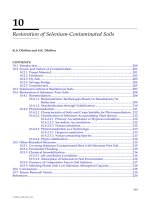Marketing Communications - Chapter 10 pdf
Bạn đang xem bản rút gọn của tài liệu. Xem và tải ngay bản đầy đủ của tài liệu tại đây (1.4 MB, 40 trang )
© 2010 South-Western, a part of Cengage Learning
All rights reserved.
PowerPoint Presentation by Charlie Cook
The University of West Alabama
Eighth Edition
Measuring Advertising
Message Effectiveness
CHAPTER
10
1. Explain the rationale and importance of message
research.
2. Describe the various research techniques used to
measure consumers’ recognition and recall of
advertising messages.
3. Illustrate measures of emotional reactions to
advertisements.
4. Explicate the role of persuasion measurement,
including pre- and post-testing of consumer
preference.
Chapter Objectives
After reading this chapter you should be able to:
© 2010 South-Western, a part of Cengage Learning. All rights reserved. 10–2
5. Explain the meaning and operation of single-source
measures of advertising effectiveness.
6. Examine some key conclusions regarding television
advertising effectiveness.
Chapter Objectives (cont’d)
After reading this chapter you should be able to:
© 2010 South-Western, a part of Cengage Learning. All rights reserved. 10–3
© 2010 South-Western, a part of
Cengage Learning. All rights
reserved. 10–4
Introduction to Advertising Research
Introduction to Advertising Research
•
Measuring Message Effectiveness
Measuring Message Effectiveness
Enables management to increase advertising’s
Enables management to increase advertising’s
contribution toward achieving marketing goals and
contribution toward achieving marketing goals and
yielding a reasonable return on investment
yielding a reasonable return on investment
•
What Does Advertising Research Involve?
What Does Advertising Research Involve?
Measures of
Measures of
media
media
effectiveness
effectiveness
Measures of
Measures of
message
message
effectiveness (
effectiveness (
later chapters
later chapters
)
)
© 2010 South-Western, a part of
Cengage Learning. All rights
reserved. 10–5
Introduction to Advertising Research
Introduction to Advertising Research
•
Stages of Advertising Research
Stages of Advertising Research
Copy development stage (pretesting)
Copy development stage (pretesting)
“
“
Rough” stage
Rough” stage
Final production stage
Final production stage
After media run (posttesting)
After media run (posttesting)
© 2010 South-Western, a part of
Cengage Learning. All rights
reserved. 10–6
Industry Standards for Message Research
Industry Standards for Message Research
Principles of the Positioning Advertising Copy Testing (PACT)
Principles of the Positioning Advertising Copy Testing (PACT)
Principle 1
Principle 1
Provide measurements that are relevant to the advertising
Provide measurements that are relevant to the advertising
objectives
objectives
Principle 2
Principle 2
Requires agreement about how the results will be used in
Requires agreement about how the results will be used in
advance of each specific test
advance of each specific test
Principle 3
Principle 3
Provides multiple measurements because single
Provides multiple measurements because single
measurements are generally inadequate
measurements are generally inadequate
Principle 4
Principle 4
Is based on a model of human response to communications
Is based on a model of human response to communications
—r
—r
eception of a stimulus, comprehension of stimulus, and
eception of a stimulus, comprehension of stimulus, and
response to stimulus
response to stimulus
Principle 5
Principle 5
Allows for consideration of whether the advertising stimulus
Allows for consideration of whether the advertising stimulus
should be exposed more than once
should be exposed more than once
© 2010 South-Western, a part of
Cengage Learning. All rights
reserved. 10–7
Industry Standards for Message Research
Industry Standards for Message Research
Principles of the Positioning Advertising Copy Testing (PACT)
Principles of the Positioning Advertising Copy Testing (PACT)
Principle 6
Principle 6
Recognizes that a more finished piece of copy can be
Recognizes that a more finished piece of copy can be
evaluated more soundly
evaluated more soundly
—alternative executions must be
—alternative executions must be
tested in the same degree of finish
tested in the same degree of finish
Principle 7
Principle 7
System provides controls to avoid the bias normally found in
System provides controls to avoid the bias normally found in
the exposure context
the exposure context
Principle 8
Principle 8
Takes into account basic considerations of sample definition
Takes into account basic considerations of sample definition
in requiring that the sample be representative of the target
in requiring that the sample be representative of the target
audience
audience
Principle 9
Principle 9
Can demonstrate consistent results (reliability) and accurately
Can demonstrate consistent results (reliability) and accurately
predicts marketplace performance
predicts marketplace performance
© 2010 South-Western, a part of
Cengage Learning. All rights
reserved. 10–8
What Do Brand Managers and Ad
What Do Brand Managers and Ad
Agencies Want to Learn from Message
Agencies Want to Learn from Message
Research?
Research?
•
Does a particular advertisement have brand
Does a particular advertisement have brand
equity-enhancing and product sales-expanding
equity-enhancing and product sales-expanding
potential?
potential?
Brand awareness
Brand awareness
Brand image
Brand image
•
Advertising Research Foundation (ARF) Study
Advertising Research Foundation (ARF) Study
Conclusion is that no one measure is universally
Conclusion is that no one measure is universally
appropriate or best.
appropriate or best.
© 2010 South-Western, a part of
Cengage Learning. All rights
reserved. 10–9
Message Research Methods
Message Research Methods
Qualitative Message
Research
Quantitative Message
Research
General Forms of
Message Research
© 2010 South-Western, a part of
Cengage Learning. All rights
reserved. 10–10
Quantitative Message Research
Quantitative Message Research
Measurement
Control
Understanding
Improvement
Research Method
Steps
© 2010 South-Western, a part of
Cengage Learning. All rights
reserved. 10–11
Market Research Measures
Market Research Measures
Measure
Measure
Recognition
Recognition
and Recall
and Recall
Assesses whether advertising has successfully
Assesses whether advertising has successfully
influenced brand awareness and influenced brand-
influenced brand awareness and influenced brand-
related thoughts and feelings
related thoughts and feelings
Emotional
Emotional
Reaction
Reaction
Provides indicators of whether advertisements
Provides indicators of whether advertisements
have emotionally aroused consumers.
have emotionally aroused consumers.
Persuasive
Persuasive
Impact
Impact
Represents prebehavioral indicators of whether an
Represents prebehavioral indicators of whether an
advertisement is likely to influence purchase intentions
advertisement is likely to influence purchase intentions
and behavior.
and behavior.
Sales
Sales
Response
Response
Determines whether an advertising campaign has
Determines whether an advertising campaign has
affected consumers’ purchases of an advertised brand.
affected consumers’ purchases of an advertised brand.
© 2010 South-Western, a part of
Cengage Learning. All rights
reserved. 10–12
Illustrative Message Research Methods
Table 10.1
© 2010 South-Western, a part of
Cengage Learning. All rights
reserved. 10–13
Measures of Recognition and Recall
Measures of Recognition and Recall
•
Starch Readership Service
Starch Readership Service
Reader awareness of magazine ads service that
Reader awareness of magazine ads service that
examines reader awareness of ads in consumer
examines reader awareness of ads in consumer
magazines and business publications
magazines and business publications
Measures the primary objective of a magazine ad—to
Measures the primary objective of a magazine ad—to
be seen and read
be seen and read
Eligible readers are classified as:
Eligible readers are classified as:
Noted
Noted
Associated
Associated
Read some
Read some
Read most
Read most
© 2010 South-Western, a part of
Cengage Learning. All rights
reserved. 10–14
Measures of Recognition and Recall (cont’d)
Measures of Recognition and Recall (cont’d)
•
Starch Readership Service’s ADNORM index
Starch Readership Service’s ADNORM index
Used to compare an advertisement’s scores against
Used to compare an advertisement’s scores against
other ads in the same product category as well as the
other ads in the same product category as well as the
same size (e.g., full page) and color classifications
same size (e.g., full page) and color classifications
(e.g., four-color ads)
(e.g., four-color ads)
© 2010 South-Western, a part of
Cengage Learning. All rights
reserved. 10–15
Starch-Rated
Advertisement for
the Kia Sorento
Figure 10.1
•
39% noted the ad
•
37% associated it
•
27% read some copy
•
10% read most of copy
© 2010 South-Western, a part of
Cengage Learning. All rights
reserved. 10–16
Measures of Recognition and Recall (cont’d)
Measures of Recognition and Recall (cont’d)
•
Bruzzone Research Company (BRC)
Bruzzone Research Company (BRC)
Conducts online testing of consumer recognition and
Conducts online testing of consumer recognition and
recall of advertisers in television commercials
recall of advertisers in television commercials
Asks subjects if they remember the advertiser’s name
Asks subjects if they remember the advertiser’s name
when reviewing the ad with anything identifying the
when reviewing the ad with anything identifying the
brand now removed
brand now removed
•
Advertising Response Model (ARM)
Advertising Response Model (ARM)
Links responses to the 27 descriptive adjectives to
Links responses to the 27 descriptive adjectives to
consumers’ attitudes toward both the ad and the
consumers’ attitudes toward both the ad and the
advertised brand and to their purchase interes
advertised brand and to their purchase interes
© 2010 South-Western, a part of
Cengage Learning. All rights
reserved. 10–17
Measures of Recognition and Recall (cont’d)
Measures of Recognition and Recall (cont’d)
•
Bruzzone Test
Bruzzone Test
Provides valid prediction of actual marketplace
Provides valid prediction of actual marketplace
performance along with being relatively inexpensive
performance along with being relatively inexpensive
Doesn’t provide a before-the-fact indication
Doesn’t provide a before-the-fact indication
Offers important information for evaluating a
Offers important information for evaluating a
commercial’s effectiveness and whether it should
commercial’s effectiveness and whether it should
continue to run
continue to run
© 2010 South-Western, a part of
Cengage Learning. All rights
reserved. 10–18
Script for Taco Bell’s “Carne Asada Taquitos” Commercial
Figure 10.2
© 2010 South-Western, a part of
Cengage Learning. All rights
reserved. 10–19
Advertising Response Model (ARM) for the
“Carne Asada Taquitos” Commercial
Figure 10.3
© 2010 South-Western, a part of
Cengage Learning. All rights
reserved. 10–20
Key Scenes and Questions
from BRC’s Test of the
“Thanking the Troops”
Commercial
Figure 10.4
© 2010 South-Western, a part of
Cengage Learning. All rights
reserved. 10–21
Advertising Response Model (ARM) for
the “Thanking the Troops” Commercial
Figure 10.5
© 2010 South-Western, a part of
Cengage Learning. All rights
reserved. 10–22
Measures of Recognition and Recall (cont’d)
Measures of Recognition and Recall (cont’d)
•
Day-After Recall Testing
Day-After Recall Testing
The Ipsos-ASI Next*TV Method
The Ipsos-ASI Next*TV Method
1.
1.
Recruit viewers
Recruit viewers
2.
2.
Mail sample video to national sample of consumers
Mail sample video to national sample of consumers
3.
3.
Consumers view video with embedded advertisements
Consumers view video with embedded advertisements
4.
4.
Day after viewing, consumers are contacted to measure
Day after viewing, consumers are contacted to measure
their reactions to the TV program and advertisements
their reactions to the TV program and advertisements
5.
5.
Calculation of message recall
Calculation of message recall
© 2010 South-Western, a part of
Cengage Learning. All rights
reserved. 10–23
Measures of Recognition and Recall (cont’d)
Measures of Recognition and Recall (cont’d)
•
Advantages of In-home Videotape Sampling
Advantages of In-home Videotape Sampling
In-home exposure makes it possible to measure advertising
In-home exposure makes it possible to measure advertising
effectiveness in a natural environment
effectiveness in a natural environment
Possible to assess the ability of TV commercials to break
Possible to assess the ability of TV commercials to break
through the clutter, gain the viewer’s attention, and influence
through the clutter, gain the viewer’s attention, and influence
message recallability and persuadability
message recallability and persuadability
Measuring recall one day after exposure, it can determined how
Measuring recall one day after exposure, it can determined how
well tested commercials are remembered after a delay period
well tested commercials are remembered after a delay period
Videotape technology allows the use of representative national
Videotape technology allows the use of representative national
sampling
sampling
By providing several alternative measures of persuasion, the
By providing several alternative measures of persuasion, the
Next*TV method allows brand managers and their ad agencies
Next*TV method allows brand managers and their ad agencies
to select the measures that best meet their specific needs
to select the measures that best meet their specific needs
© 2010 South-Western, a part of
Cengage Learning. All rights
reserved. 10–24
Measures of Recognition and Recall (cont’d)
Measures of Recognition and Recall (cont’d)
•
The Recall Controversy
The Recall Controversy
Recall simply measures whether an ad is received
Recall simply measures whether an ad is received
but not whether the message is accepted
but not whether the message is accepted
Recall is age-biased in favor of younger consumers
Recall is age-biased in favor of younger consumers
Recall scores generated by ads are not predictive of
Recall scores generated by ads are not predictive of
sales performance
sales performance
—
—
scores and sales do not increase
scores and sales do not increase
in tandem
in tandem
Recall testing understates the memorability of
Recall testing understates the memorability of
commercials that employ emotional or feeling-
commercials that employ emotional or feeling-
oriented themes and is biased in favor of rational or
oriented themes and is biased in favor of rational or
thought-oriented commercials
thought-oriented commercials
© 2010 South-Western, a part of
Cengage Learning. All rights
reserved. 10–25
Measurement of Emotional Reactions
Measurement of Emotional Reactions
Brain Imaging
(fMRI)
Self-Report Measures
(Verbal and Visual)
Physiological Measures
(Galvanometer and
Pupillometer)
Measuring Consumers’
Emotional Responses
to Advertisements









